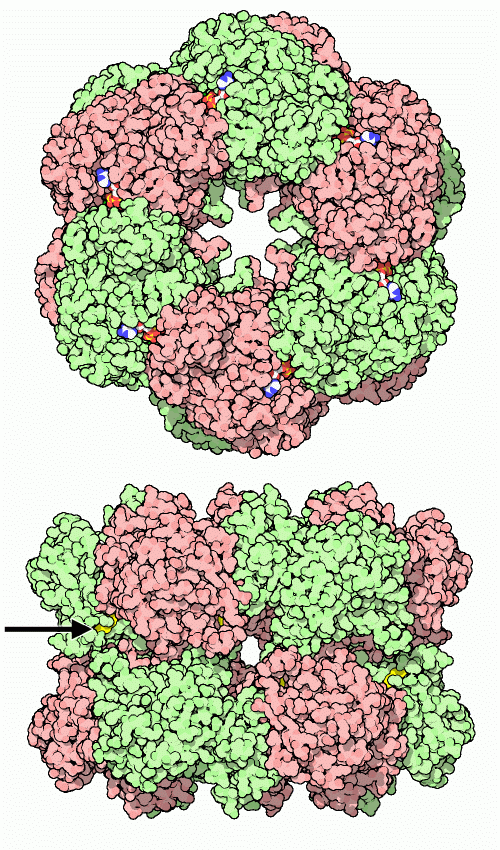|
Inhaltsübersicht | Nanomaschinen | Moleküle | Programme | Kurse | Fun | Links |
||
| > |
Glutamine Synthetase

Our cells are continually faced with a changing environment. Think about what you eat. Some days you might eat a lot of protein, other days you might eat a lot of carbohydrate. Sometimes you may eat nothing but chocolate. Your body must be able to respond to these different foods, producing the proper enzymes for capturing the nutrients in each. The same is doubly true for small organisms like bacteria, which do not have as many options in choosing their diet. They must eat whatever food happens to be close by, and then mobilize the enzymes needed to use it.
A Molecular Computer
The enzyme glutamine synthetase is a key enzyme controlling the use of nitrogen inside cells. Glutamine, as well as being used to build proteins, delivers nitrogen atoms to enzymes that build nitrogen-rich molecules, such as DNA bases and amino acids. So, glutamine synthetase, the enzyme that builds glutamine, must be carefully controlled. When nitrogen is needed, it must be turned on so that the cell does not starve. But when the cell has enough nitrogen, it needs to be turned off to avoid a glut.Glutamine synthetase acts like a tiny molecular computer, monitoring the amounts of nitrogen-rich molecules. It watches levels of amino acids like glycine, alanine, histidine and tryptophan, and levels of nucleotides like AMP and CTP. If too much of one of these molecules is made, glutamine synthetase senses this and slows production slightly. But as levels of all of these nucleotides and amino acids rise, together they slow glutamine synthetase more and more. Eventually, the enzyme grinds to a halt when the supply meets the demand.
Communication Between Many Active Sites
The glutamine synthetase molecule shown here (PDB entry 1fpy) is from bacteria. It is composed of twelve identical subunits, each of which has an active site for the production of glutamine. When performing its reaction, the active site binds to glutamate and ammonia, and also to an ATP molecule that powers the reaction. But, the active sites also bind weakly to other amino acids and nucleotides, partially blocking the action of the enzyme. All of the many sites communicate with one another, and as the concentrations of competing molecules rise, more and more of the sites are blocked, eventually shutting down the whole enzyme. The cell has a more direct approach when it wants to shut down the enzyme. At a key tyrosine next to the active site, colored yellow here and shown by the arrow, an ADP molecule can be attached to the protein, completely blocking its action.Lack of Control
We make several versions of glutamine synthetase in our own cells. Most of our cells make a version similar to the bacterial one shown here, but with eight subunits instead of twelve. Like the bacterial enzyme, it is controlled by the nitrogen-rich compounds down the synthetic pipeline. We also make a second glutamine synthetase in our brain. There, glutamate is used as a neurotransmitter, and glutamine synthetase is used when the glutamate is recycled after a nerve impulse is delivered. In the brain, glutamine synthetase is in constant action, so a highly-regulated version is not appropriate. Instead, the alternate form is active all the time, continually performing its essential duty.Next: Two Doors
Last changed by: A.Honegger,